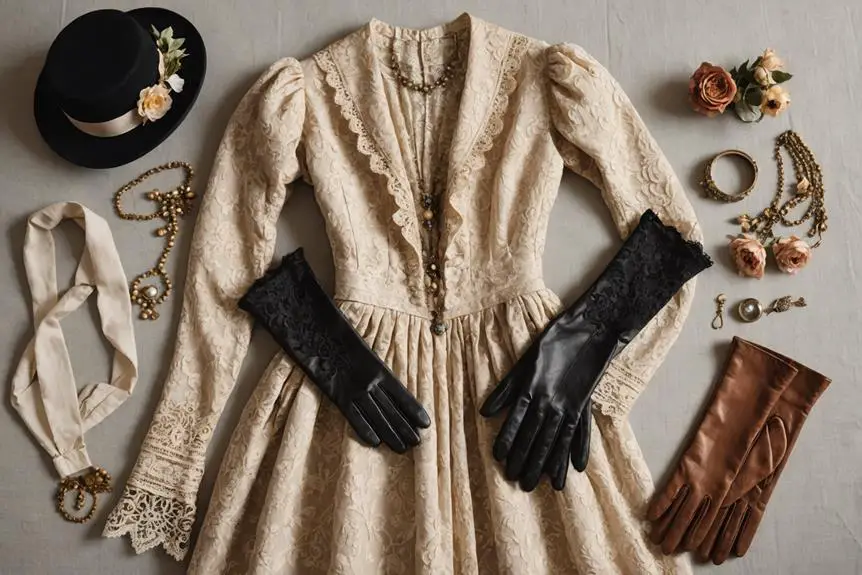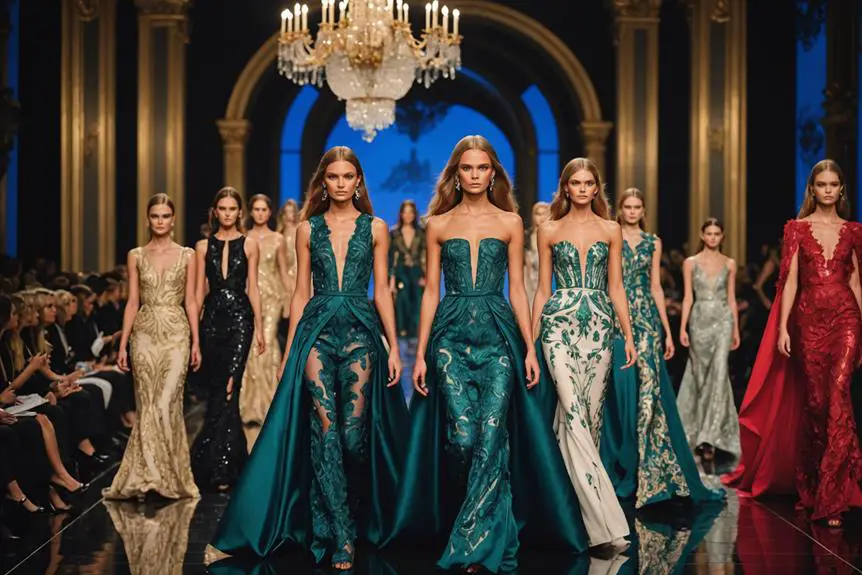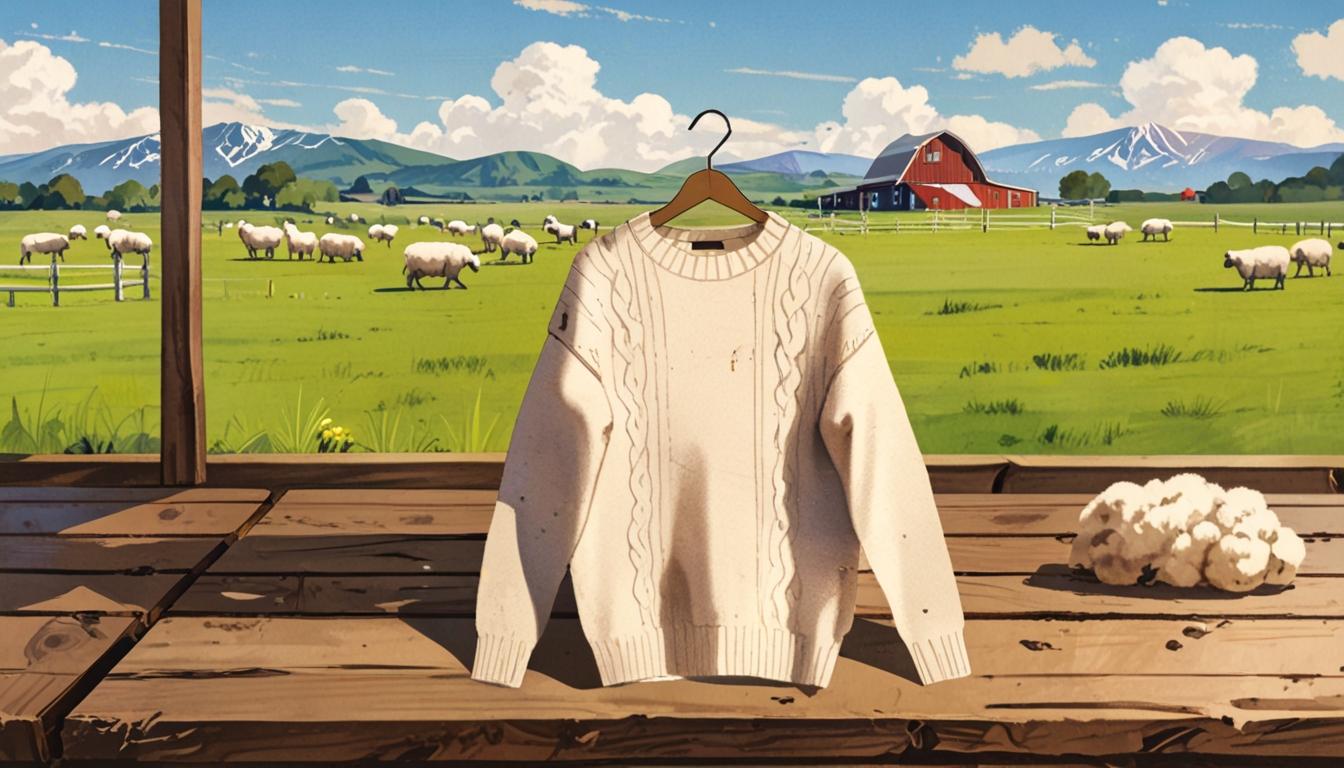When you consider the outfits in "Pride & Prejudice" (2005), it becomes clear how integral they are to understanding the characters and their societal roles. Each piece, from Lizzy's understated dresses to the opulent attire of Darcy and Bingley, reveals layers of class dynamics and personal transformation. Jacqueline Durran's design choices convey not just fashion, but the emotional landscape of the story. Yet, there's more beneath the surface of these garments that invites a closer look at the subtleties of costume design—what might these choices reveal about the era and the characters' journeys?
Historical Context of Costuming
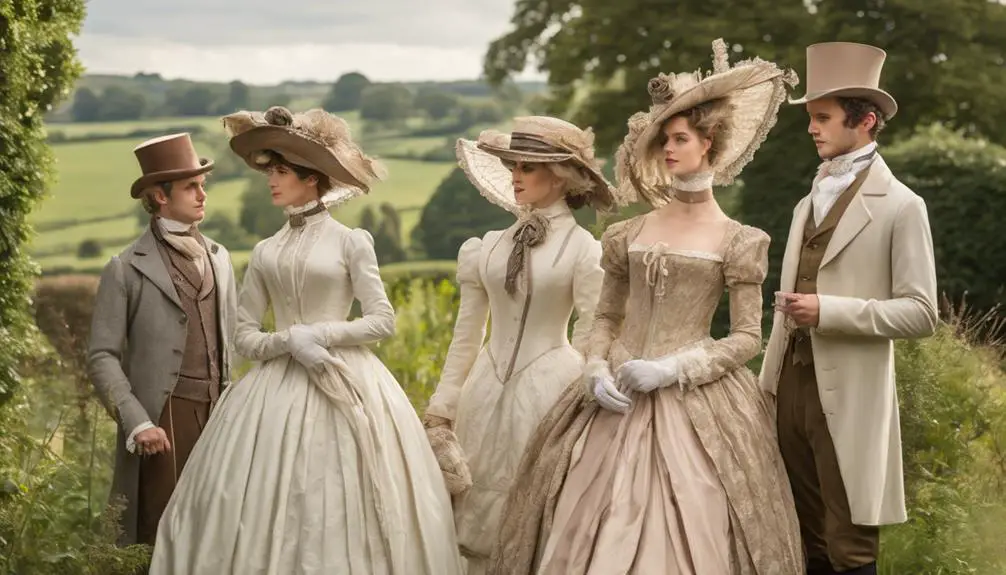
The historical context of costuming in *Pride & Prejudice* plays an essential role in bringing the story to life. Set in the late 18th century, around 1797, the film reflects the fashion trends of the time. You might notice that natural waistlines were all the rage, and costume designer Jacqueline Durran embraced this style to create flattering silhouettes. Doesn't it make you appreciate how clothes can shape a character?
One of the coolest aspects of the costumes is how they tell a story about social class. The Bennet family, for instance, wears lower-middle-class attire, while wealthier characters flaunt more refined clothing. This contrast highlights the class dynamics of the era, making it easier for you to understand the struggles and aspirations of the characters. Plus, Durran used practical fabrics like cotton and wool, perfect for outdoor scenes. It's like she thought of everything!
While some creative liberties were taken, the costumes still aimed for historical accuracy, grounding the film in its time. You can almost feel the weight of history with every gown and jacket. So, next time you watch the movie, pay close attention to how the costumes enhance the characters and their stories. It's not just about looking pretty; it's about immersing you in a world that feels real. And let's be honest, who doesn't want to step back into such a charming, beautifully costumed era?
Costume Design Choices
Costume designer Jacqueline Durran made bold choices in the 2005 adaptation of *Pride & Prejudice*, setting it apart from earlier versions. Instead of sticking to the unflattering high waistlines of past adaptations, she opted for natural waistlines that flatter the figures of the characters, especially the younger ones. This fresh approach really makes the film stand out!
Here are three standout costume design choices that you'll love:
- Earthy Tones: Durran used earthy colors and practical fabrics like cotton and wool. This choice perfectly matches the film's rustic setting and gives the characters a relatable, down-to-earth vibe.
- Character-Specific Outfits: Lizzy Bennet's staple brown cotton dress really symbolizes her character's grounded nature. Then, at the Netherfield ball, her stunning white dress marks a turning point in her journey—what a visual treat!
- Visual Cohesion: The costumes in the film aren't just pretty to look at; they also enhance the story's themes. Each outfit reflects the characters' emotions and development, helping you connect with them on a deeper level.
Character Development Through Outfits
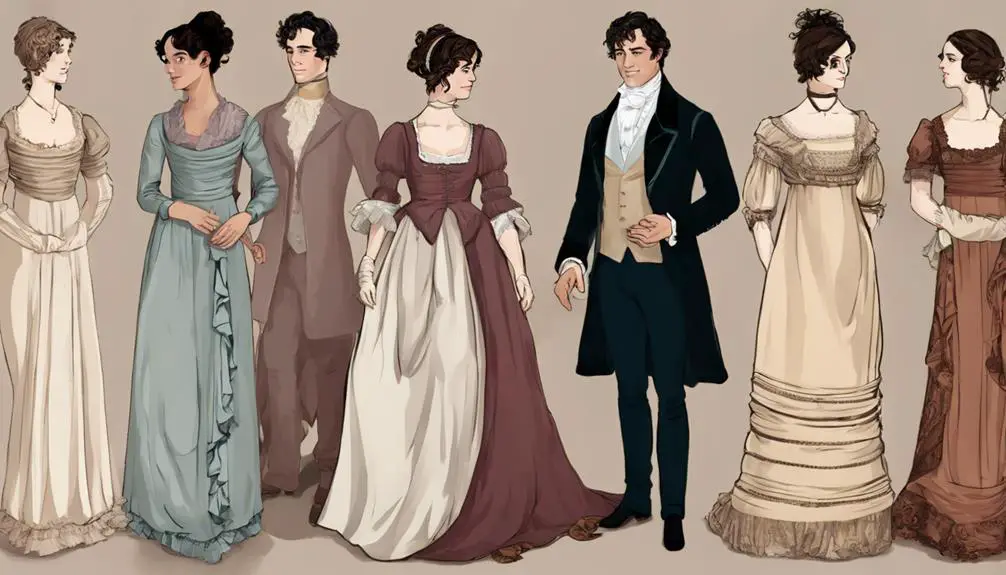
Let's talk about how outfits in *Pride & Prejudice* really show character growth! You'll notice Lizzy's wardrobe transforms from practical earthy tones to elegant dresses, which totally reflects her rising confidence and emotional journey. And don't forget Mr. Darcy—his shift from stiff formal wear to more relaxed styles reveals his vulnerability and personal growth, too. Isn't it fascinating how clothes can tell such a powerful story?
Costume Evolution Significance
Exploring the significance of costume evolution in "Pride and Prejudice" reveals how outfits play a essential role in character development. You'll notice that each outfit reflects key moments and emotions, making the film's story come alive. Take a look at these highlights:
- Lizzy Bennet's wardrobe shifts from her staple brown cotton dress to the elegant white dress at the Netherfield ball, showing her growth and changing feelings.
- Mr. Darcy's formal attire at first emphasizes his aloofness, but as he sheds those layers for more relaxed clothing, you can see his journey toward vulnerability and acceptance.
- The contrast between Mr. Darcy and Mr. Bingley's styles highlights their personalities, with Bingley's approachable looks showcasing his friendly nature.
Jacqueline Durran's thoughtful design choices, like earthy tones and practical fabrics, enhance visual storytelling while revealing how characters relate to their environment. Each costume change is not just for show; it's a significant part of the narrative, helping you connect with Lizzy and Mr. Darcy on a deeper level. So, next time you watch, pay attention—those outfits tell a story all their own!
Symbolism in Outfit Choices
Now, let's talk about that stunning emerald dress she wears during pivotal moments. It showcases her vibrant personality and emotional depth, especially during those key interactions with Mr. Darcy. Speaking of him, his evolving attire says a lot! He goes from stiff and formal to relaxed and approachable, mirroring his journey from pride to vulnerability.
And don't forget Mr. Bingley's lighter, softer clothing. It's a stark contrast to Darcy's darker outfits, highlighting their different personalities and social styles. Finally, Lizzy's white dress at the Netherfield ball is significant. It marks a turning point in her relationship with Darcy, reflecting her inner battle between societal norms and personal desire. Talk about a modern spin on classic symbolism! How cool is that?
Class Representation in Fashion
When you watch *Pride & Prejudice*, you can't help but notice how the costumes tell a story about class. The Bennets wear simpler outfits that show their lower middle-class status, while the wealthier folks strut around in fancy fabrics that practically scream luxury. Isn't it fascinating how fashion reflects social hierarchy, especially during those grand balls where everyone mingles?
Costume Symbolism and Class
Costume symbolism in *Pride & Prejudice* (2005) vividly illustrates the complex class dynamics of the late 18th century. You can really see how the characters' clothing reflects their social standings. The Bennet family's simpler dresses show their lower middle-class status, contrasting sharply with the elegance of wealthier characters like the Bingleys. Isn't it interesting how Mr. Bennet's country gentleman look tells you so much about him?
Here are three key points to evaluate:
- Quality vs. Simplicity: The differences in fabric and style highlight class distinctions.
- Social Gatherings: Balls mix different classes, challenging the strict rules of the time and showing a blend of social dynamics.
- Visual Storytelling: Costumes reveal character relationships and societal roles, emphasizing themes of classism in Austen's story.
These outfits don't just look pretty; they help you understand the characters' lives and struggles. So, the next time you watch, pay attention to the costumes. They're more than just fashion—they're a window into the world of class dynamics. Isn't that a cool way to look at it?
Historical Fashion and Hierarchy
In the world of *Pride & Prejudice* (2005), historical fashion plays an essential role in illustrating social hierarchy and class representation. You can really see how the clothes reflect class dynamics of late 18th-century England. The Bennets, despite their struggles, are shown as lower middle class, which is interesting since Mr. Bennet, the country gentleman, hints at a higher social standing. But wait—look closely at their clothing! It shows their financial difficulties within that upper tier.
Now, the film's fancy balls? They're supposed to be exclusive to the upper classes, yet we see mixed-class interactions, which muddles the true social structure. Isn't it funny how Mrs. Bennet's outfits mix 1770s and 80s styles? This disrupts the visual continuity and dilutes the class themes Austen intended. It's like a fashion faux pas that shouts, "I'm trying too hard!"
Aesthetic Elements and Visual Storytelling
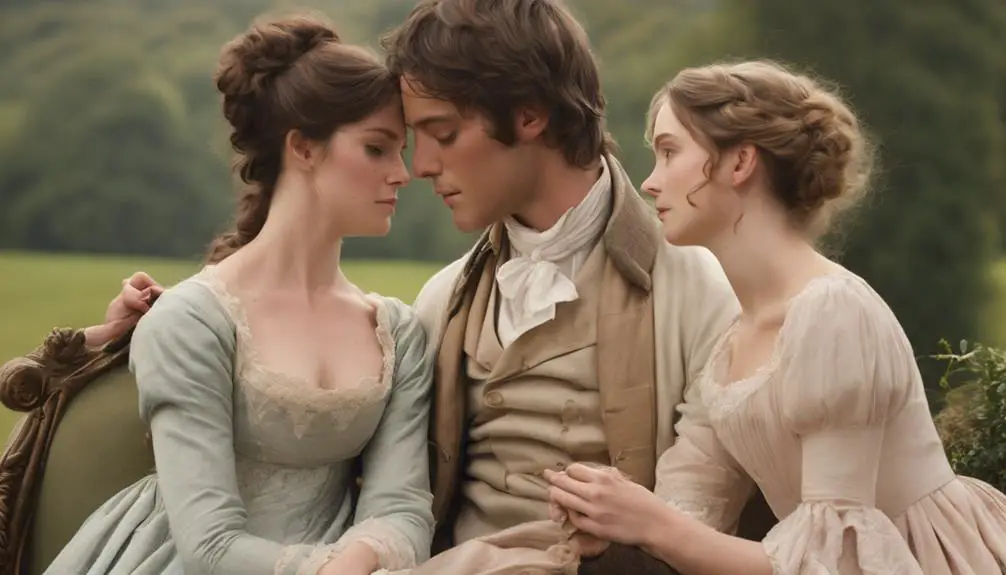
The film "Pride and Prejudice" masterfully employs aesthetic elements to enhance visual storytelling, creating a rich tapestry that reflects the characters' emotional journeys and the world they inhabit. You can really see how the costume design plays a key role in this, right? It's not just about looking pretty; it actually helps us understand who the characters are.
- Earthy Color Palette: The costumes feature earthy tones that connect to the English countryside, giving the film a rustic feel. This connection makes you feel like you're right there with Lizzy and Darcy, doesn't it?
- Character Evolution: Take a closer look at Lizzy Bennet's wardrobe. The practical fabrics and colors symbolize her bond with nature and her growth throughout the movie. And let's not forget Mr. Darcy! His shift from formal attire to simpler clothing shows his character development, revealing his vulnerability.
- Layering Techniques: The use of layers, like shawls and coats, is so clever. It reflects both the practical needs of the characters and the fashion of the late 18th century. Plus, it adds depth to their personalities!
In "Pride and Prejudice," every costume tells a story. You've got to appreciate how visual storytelling and costume design work hand in hand, don't you think? So, next time you watch, pay close attention to those outfits—they're more than just clothes; they're a window into the characters' souls!
Inconsistencies in Costume Accuracy
While the costumes in "Pride and Prejudice" enhance the film's visual storytelling, several inconsistencies in costume accuracy can disrupt the immersion. You might find yourself wondering how some outfits made it past the design team. For instance, the male hairstyles and clothing styles vary so much that it feels like a fashion show through the ages. Are we supposed to believe these characters are all from the same time period?
Then there's Mrs. Bennet. Her wardrobe mixes styles from the 1770s and 1780s, which is a bit confusing since the story is set in the late 18th century. It's like she raided a historical thrift store! And let's not forget the ball scene. You'd expect elegance, but the chaotic fashion choices don't exactly scream historical accuracy. Instead, they undermine the film's worldbuilding.
Even Lizzie Bennet's hair, which tries to capture the look of the time, falls short of the voluminous curls that were all the rage. What's a girl gotta do to get those curls right? As for Kitty and Lydia, their costumes might be accurate for children, but they feel totally off for young adults. It's like dressing up for a school play instead of a grand ball!
These costume inconsistencies can pull you out of the story, making you question the attention to detail. So next time you watch, keep an eye out for these fashion faux pas!
Cultural Themes Reflected in Costumes
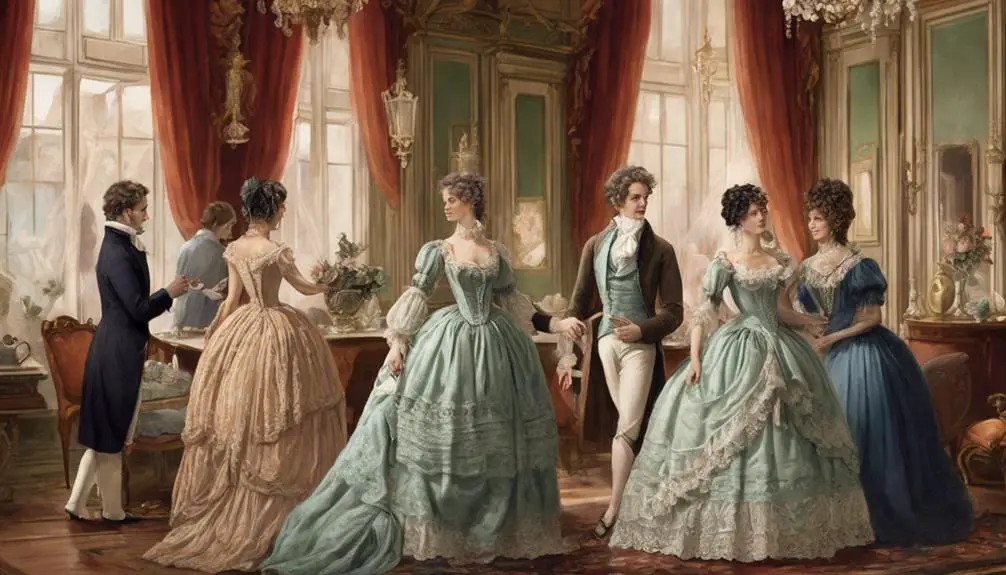
Costumes vividly illustrate the cultural themes in the 2005 adaptation of *Pride and Prejudice*, capturing the nuances of class dynamics in late 18th-century England. You can really see how the costumes reflect the characters' social standings, especially when you compare the Bennet family's simpler outfits to the lavish attire of Mr. Darcy and Mr. Bingley. It's like a visual lesson in class hierarchy!
Here are three key aspects of how costumes enhance these themes:
- Color Choices: The Bennets often wear earthy tones, showing their lower middle-class status. In contrast, Mr. Darcy's elegant outfits in rich fabrics highlight his wealth and social position. It's a clear representation of who's who in society.
- Character Representation: Lizzy Bennet's practical brown cotton dress perfectly showcases her down-to-earth personality and connection to nature. This simple yet meaningful choice reflects her resilience and desire for personal growth in a world filled with societal expectations.
- Social Settings: The film's balls present a mixed-class portrayal that slightly bends the strict class lines of Austen's original work. This visual representation adds a modern twist, engaging today's audience with themes of love that transcend social barriers.
Iconic Outfits of Lizzy Bennet
Lizzy Bennet's wardrobe in the 2005 adaptation of *Pride and Prejudice* vividly captures her character's essence and evolution throughout the film. You can see how her outfits reflect her personality and journey. For instance, take her staple brown cotton dress—it's super practical, just like Lizzy herself. This outfit shows her resilience against the stuffy social norms of the time. It's perfect for a girl who's all about being true to herself!
Now, let's talk about that stunning emerald dress she wears at Netherfield. Wow! That bold color really highlights Lizzy's spirited personality and charm, making her a standout among the guests. And don't forget her indigo dress, which is a bit of a chameleon! Depending on the lighting, it changes, just like how people see Lizzy differently throughout the story. Pretty cool, right?
Then there's the white dress she wears at the Netherfield ball. This outfit is a big deal! It represents a turning point in her life, showing how important that social event is for her character development. Plus, it's just gorgeous!
Frequently Asked Questions
What Is the Clothing Style in Pride and Prejudice?
The clothing style blends Victorian elegance with Regency trends, emphasizing natural waistlines and earthy tones. You'll notice layered textures, practical fabrics, and distinct silhouettes that reflect social roles and character evolution throughout the story.
Is the Fashion in Pride and Prejudice Accurate?
You might think the fashion accuracy in period films is flawless, but in reality, the costume design often bends history. It prioritizes visual appeal, leaving strict adherence to historical styles in the dust.
Is Pride and Prejudice 2005 Historically Accurate?
You'll find that the film's historical context is often compromised. While the costume design aims for visual appeal, it mixes styles, leading to inaccuracies that may disappoint those seeking true representation of the late 18th century.
What Era Is Pride and Prejudice 2005 Set In?
The 2005 adaptation's set during the Regency Era, around 1797. This period reflects unique social customs, emphasizing class dynamics and gender roles, which greatly influence character interactions and relationships throughout the story.
